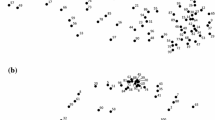Abstract
The correspondence between theory and observation is often evaluated by a comparison between a hypothesized constraint matrix and the spatial representation of a pxp similarity matrix. This comparison of constraint and proximity matrices assumes the accurate translation of similarities to proximities. If the translation is not exact (i.e., a stress or alienation coefficient greater than zero), the hypothesized structure is evaluated using a false representation of the observed data. The proposed model eliminates the need for spatial representation by making a direct comparison between the hypothesized constraint matrix and the multivariate structure of the bivariate similarities. Goodness of fit indices are used for three model comparisons; (1) single data set, one hypothesized structure; (2) single data set, two hypothesized structures; and (3) two data sets, one hypothesized structure.
Similar content being viewed by others
References
Borg, I. and Lingoes, J. C. (1979). Multidimensional scaling with side constraints on the distance. In J. C. Lingoes, E. E. Roskam and Borg (eds.), Geometric Representations of Relational Data, 2nd ed. Ann Arbor: Mathesis Press.
Borg, I. and Lingoes, J. C. (1980). A model and algorithm for multidimensional scaling with external restrictions on the distances. Psychometrika 45: 25–38.
Borg, I. and Lingoes, J. C. (1981). An alternative approach to confirmatory inference and geometric model. Quality and Quantity 15: 541–552.
Borg, I. and Lingoes, J. C. (1987). Multidimensional Similarity Structure Analysis. New York: Springer-Verlag.
Groves, M. A. (1987). A Coefficient of Association for Observed Distributions. Paper presented at the First Conference of the International Federation of Classification Societies, Aachen, Germany, June 30.
Groves, M. A. (1990). The Measurement of Individual Differences in Environmental Cognition. Ph.D. Dissertation, Department of Architecture, University of Sydney, Australia.
Groves, M. A. (1991). They arrive one after another. Environment and Behavior (in press).
Guttman, L. (1968). A general nonmetric technique for finding the smallest coordinate space for a configuration of points. Psychometrika 33: 469–506.
Guttman, L. (1982). What is not what in theory construction. In I. Borg (ed.), Multidimensional Data Representations: When and Why. Ann Arbor: Mathesis Press.
Hotelling, H. (1940). The selection of variates for use in prediction with some comments on the general problem of nuisance parameters. Annals of Mathematical Statistics 11: 271–283.
Hubert, L. J. and Arabie, P. (1989). Combinational data analysis: Confirmatory comparisons between sets of matrices. Applied Stochastic Models and Data Analysis 5: 271–325.
Hubert, L. J. and Golledge, R. G. (1981). A heuristic method for the comparison of related structures. Journal of Mathematical Psychology 23: 214–226.
Hubert, L. J. and Subkoviak, M. J. (1979). Confirmatory inference and geometric models. Psychological Bulletin 86: 361–370.
Lingoes, J. C. (1981). Testing regional hypotheses in multidimensional scaling. In I. Borg (ed.), Multidimensional Data Representations: When and Why. Ann Arbor: Mathesis Press.
Lingoes, J. C. (1987). Guttman-Lingoes Nonmetric PC Series. Ann Arbor: Mathesis Press.
Lingoes, J. C. and Borg, I. (1978). CMDA-U: Confirmatory monotone distance analysis-unconditional. Journal of Marketing Research 15: 610–611.
Lingoes, J. C. and Borg, I. (1983). A quasi-statistical model for choosing between alternative configurations derived from ordinally constrained data? British Journal of Statistical Psychology 36: 36–53.
Lingoes, J. C. and Borg, I. (1986). On evaluating the equivalency of alternative MDS representations. Quality and Quantity 120: 249–256.
Steiger, J. H. (1980). Tests for comparing elements of a correlation matrix. Psychological Bulletin 87: 245–251.
Williams, E. J. (1959). The comparison of regression variables. Journal of the Royal Statistical Society, Series B 21: 296–399.
Author information
Authors and Affiliations
Rights and permissions
About this article
Cite this article
Groves, M.A. Beyond spatial representation. Qual Quant 26, 49–59 (1992). https://doi.org/10.1007/BF00177997
Issue Date:
DOI: https://doi.org/10.1007/BF00177997




